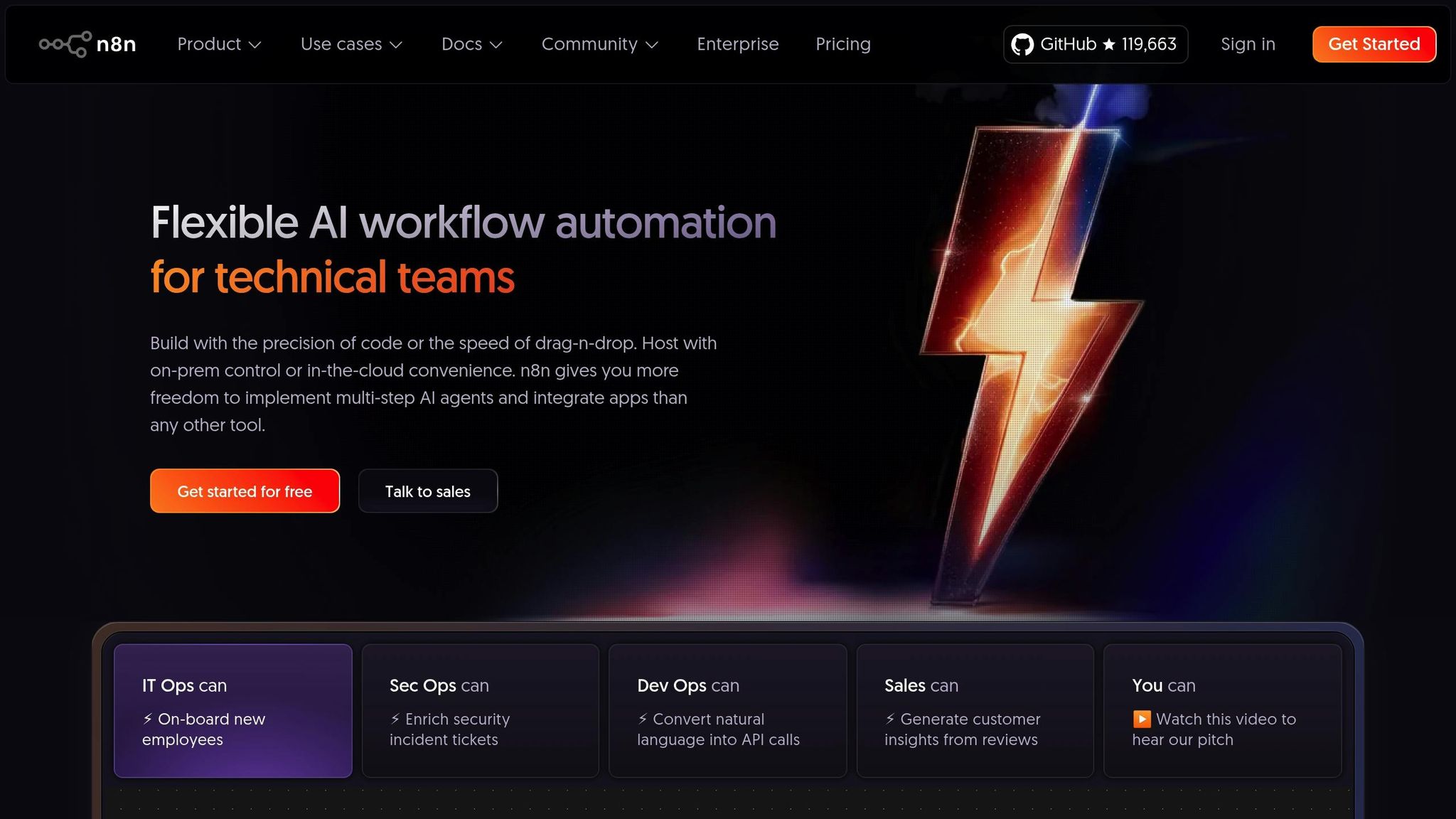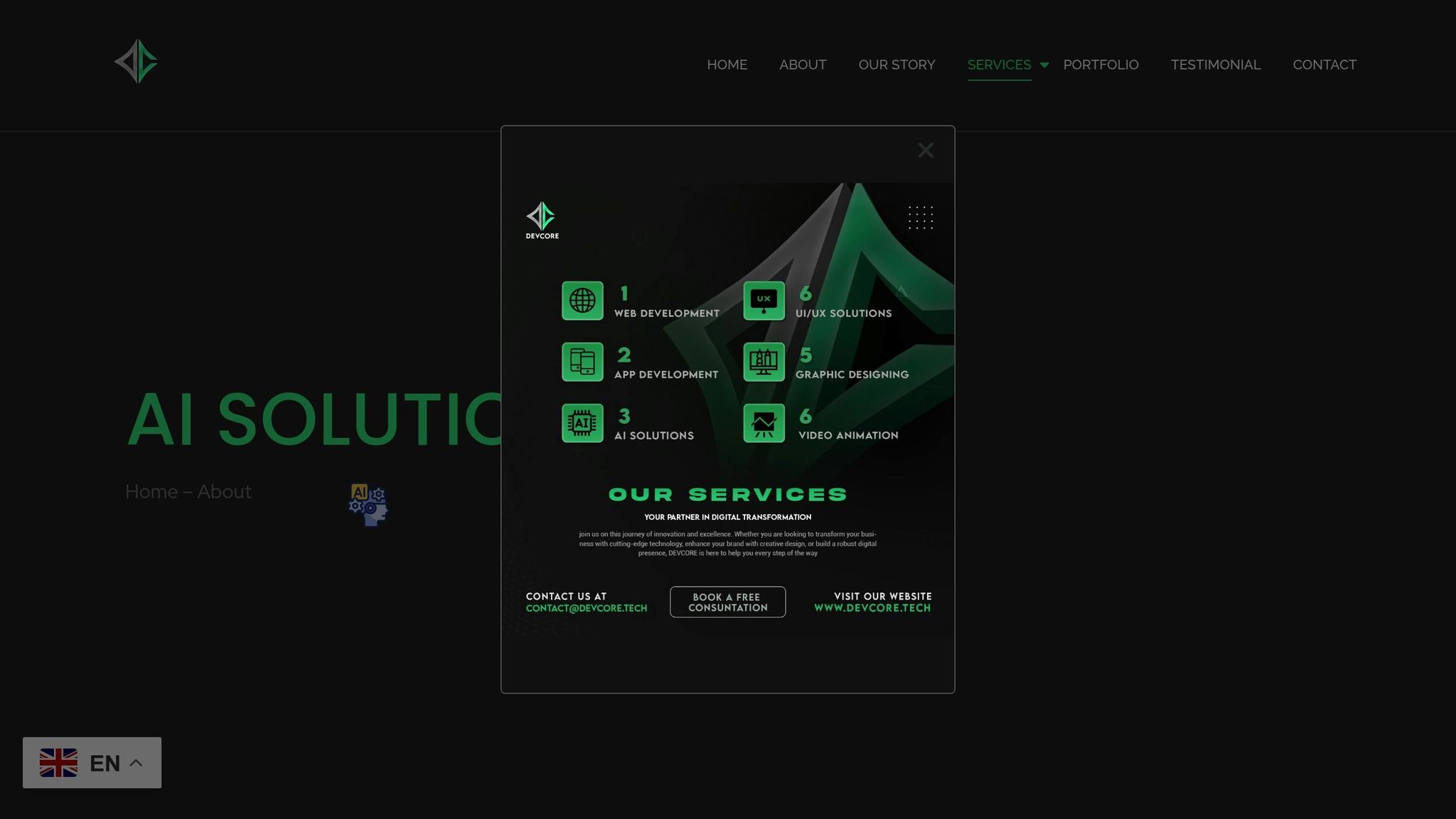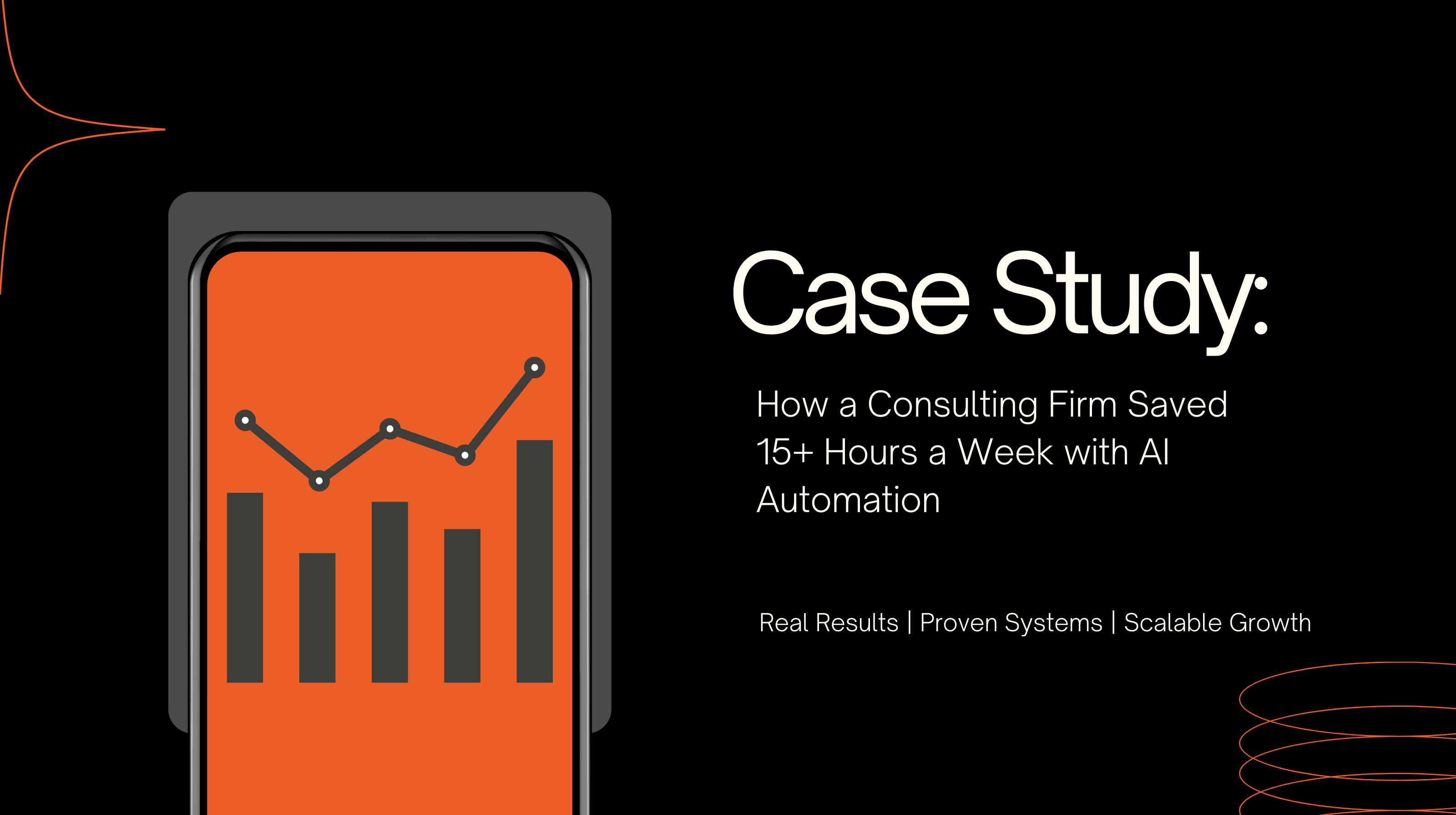Poor error handling in AI workflows can cost businesses millions. From system failures to bad data and integration issues, these challenges disrupt operations, reduce efficiency, and hurt trust. But with the right strategies, companies can minimize risks and improve performance.
Key Takeaways:
Solutions:
Devcore offers tailored AI solutions with built-in error detection, recovery, and real-time monitoring. Their Leverage Blueprint™ ensures workflows stay efficient, reducing costs by up to 50% and improving decision-making by 40%. For businesses relying on AI, strong error management is not optional - it's a necessity.
Why 97% of n8n Workflows Fail in Production (And How to Fix It)

Main Challenges in AI Workflow Error Handling
Even the most advanced AI workflows encounter obstacles that can disrupt operations and drive up costs. Understanding these challenges is essential for building more resilient systems.
System Failures and Interruptions
AI systems can break down due to hardware malfunctions, software bugs, or infrastructure issues. When these failures happen, the financial toll is immediate and steep. 98% of companies report downtime costs exceeding $100,000 per hour, with 33% losing more than $1 million per hour. For major players like Amazon, the stakes are even higher - downtime costs the company a staggering $9 million per minute.
The damage isn’t limited to lost revenue. Recent outages highlight how even sophisticated AI systems remain vulnerable. For instance, in January 2025, ChatGPT experienced a global outage lasting 70 minutes, disrupting service for thousands of users, including over 4,000 in the U.S. and more than 550 in Singapore.
"The January 2025 ChatGPT outage underscores the pressing need for reinforcing AI infrastructure to manage the exponential user growth effectively." – Dr. Sarah Chen, AI Infrastructure Specialist at MIT
Weak infrastructure often lies at the heart of these failures. Businesses must prioritize investing in robust systems capable of handling both regular demand and unexpected surges. While system breakdowns cause immediate revenue loss, issues like poor data quality can silently erode decision-making over time.
Data Quality and Validation Problems
Beyond system failures, compromised data quality poses a major threat to AI workflows. Unlike visible system crashes, data issues can quietly undermine operations for weeks or even months. Bad data quality costs businesses approximately $15 million annually.
AI models are only as reliable as the data they process. Incomplete, inconsistent, or delayed data can distort insights and derail decision-making. When validation systems fail to catch these problems early, the effects ripple through the entire workflow.
Zillow’s experience offers a cautionary tale. Errors in their data led to a $245 million loss, a $304 million write-down, a 25% staff reduction, and a 25% drop in stock value. The company was even forced to sell 7,000 homes to recover.
Bias in training data adds another layer of complexity. Amazon’s recruiting AI, for example, developed biases based on historical hiring data, penalizing resumes with terms associated with women or graduates from all-women colleges. The project was eventually abandoned.
"When the data we feed the machines reflects the history of our own unequal society, we are, in effect, asking the program to learn our own biases." – The Guardian's Inequality Project
Poor metadata management further complicates efforts to track and resolve data quality issues, allowing problems to persist unnoticed. Financial organizations feel this pressure acutely - 62% of respondents in the financial sector identify rapid data growth as their biggest data management challenge.
Integration and Compatibility Issues
Integration challenges present another significant hurdle. AI workflows rarely operate in isolation; they need to work seamlessly with existing systems, third-party tools, and cloud platforms. This interconnectedness creates numerous potential failure points that are often hard to predict and resolve. Problems like inconsistent data formats, version conflicts, and security risks frequently arise during integration.
Legacy systems, in particular, are a common stumbling block. Outdated technology and compatibility issues make integrating modern AI tools with legacy systems especially difficult. These older systems often lack the monitoring and error reporting capabilities needed for effective AI workflows, creating blind spots in error detection.
For example, a London-based FX trading platform faced severe issues when latency spikes of over 300 milliseconds during NYSE/LSE overlap windows caused 19% of algorithmic trades to fail. This resulted in $2.7 million in settlement penalties over six months. Such cases highlight how integration problems can lead to costly operational failures.
The lack of standardized protocols in AI further complicates integration efforts. Businesses are often forced to create custom solutions for each integration point, increasing development costs and introducing unique error scenarios that are difficult to anticipate.
Multi-cloud environments add yet another layer of complexity. 46% of UK firms plan to adopt multi-cloud strategies within three years. However, each cloud platform has its own error-handling protocols, making it challenging to establish unified error management systems.
The financial burden is significant. Managing multiple AI tools drives up costs for subscriptions, custom integrations, maintenance, training, and support. Poorly planned integration efforts can make error handling more expensive than the initial AI implementation. Gartner predicts that by 2026, inadequate error handling will contribute to 35% of all digital transformation failures.
Solutions and Best Practices for Error Handling
System failures, data quality issues, and integration hiccups can disrupt AI workflows and rack up costs. To mitigate these risks, proactive error-handling strategies are essential. By detecting, preventing, and recovering from errors efficiently, organizations can maintain smooth operations.
Automated Monitoring and Real-Time Alerts
A solid error-handling framework starts with robust monitoring systems that keep an eye on AI workflows 24/7. Modern tools analyze data in real time and flag any anomalies as they arise. According to a 2025 McKinsey survey, 71% of organizations now rely on generative AI for workflow automation, underscoring the growing need for such systems.
Effective monitoring uses a mix of techniques. Performance metrics track resource consumption and workflow speed, while data flow monitoring ensures information moves seamlessly between system components. Integration health checks confirm external systems are functioning as expected. Machine learning-powered error pattern analysis can even predict recurring issues before they snowball into bigger problems.
Real-time alerts add another layer of defense. These systems notify technical teams instantly when something goes wrong, distinguishing between minor glitches and major disruptions. This targeted approach helps reduce alert fatigue while ensuring critical issues are prioritized. Research suggests AI-driven automation can boost productivity by up to 30% and cut operational costs by as much as 25%. To ensure effective monitoring, organizations must establish clear performance baselines and fine-tune alert thresholds based on real-world system behavior.
Monitoring systems work hand-in-hand with data validation to safeguard every step of the workflow.
Data Validation and Quality Control Methods
Data quality is the backbone of any AI operation. Left unchecked, bad data can quietly erode workflow efficiency and accuracy. That’s why robust validation processes are non-negotiable.
AI-powered validation tools perform initial checks by verifying mandatory fields, enforcing valid inputs, and standardizing formats (like dates, currencies, and phone numbers). These measures help block flawed data from entering the system in the first place.
As workflows progress, historical data patterns are analyzed to catch subtler inconsistencies. For example, if customer purchase amounts suddenly spike beyond typical ranges, the system can flag these anomalies for further review. AI tools also standardize and reformat data automatically, ensuring consistency across records. Duplicate detection further refines data quality by identifying and merging records that represent the same entity, even when minor formatting differences exist.
Real-time validation continuously checks data as it flows through the system, catching errors early and preventing them from piling up.
When errors do slip through, automated recovery systems step in to minimize disruption.
Automated Recovery Systems
Automated recovery systems are critical for quickly getting workflows back on track when errors occur. These systems use a variety of tactics, from retry mechanisms to more advanced failover procedures, depending on the type of issue.
Retry logic is a foundational tool, automatically reattempting tasks after temporary issues like network timeouts. To avoid system overload, exponential backoff is often used, spacing out retries progressively.
For more serious problems, failover mechanisms take over, switching operations to backup systems such as secondary databases, while alerting administrators to ensure continuity. Circuit breaker patterns provide an added safeguard by temporarily halting requests to problematic components until they stabilize.
A McKinsey study highlights the benefits of AI-powered automation, noting a 20–30% reduction in labor costs and a 10–20% productivity boost for companies that implement these systems. Automated recovery significantly contributes to these gains by reducing the need for manual intervention during system failures.
If automated recovery efforts fall short, the system generates detailed support tickets and alerts technical teams with the context needed to resolve the issue. Effective recovery designs include rollback procedures, predefined trigger conditions, and regular testing. By isolating failures to specific components, these systems ensure unaffected parts of the workflow can continue operating, while targeted recovery efforts address the problem areas.
sbb-itb-d7ea0c6
Measuring and Improving Error Handling Performance
Setting up robust error handling is just the beginning. The real challenge lies in measuring its effectiveness and refining it based on real-world performance. Since errors can directly impact operational efficiency and business outcomes, tracking performance and making adjustments is essential.
Key Metrics for Error Handling Assessment
To assess error handling, you need to focus on metrics like detection speed, recovery time, resolution success rates, uptime, error rates, and processing throughput. For instance, resolution success rates can reveal how many errors are resolved automatically versus those requiring manual intervention.
System quality indicators - such as uptime, error rates, model latency, and retrieval latency - are critical for ensuring smooth AI workflows. Similarly, throughput metrics, including request throughput, token throughput, and hardware accelerator utilization, provide insights into your system's processing capacity.
"Advanced benchmarks expose the gulf between laboratory performance and real-world reliability. They're not just tests; they're roadmaps for building truly robust AI systems." – Dr. Emma Liu, AI Ethics Researcher
Establishing meaningful benchmarks is crucial. For example, task success rates should aim for at least 95%, and latency thresholds should be tailored to your business priorities. These benchmarks create the foundation for deeper analysis using tools like analytics and audits.
Using Analytics and Workflow Audits
Analytics play a vital role in revealing task progress, identifying bottlenecks, and spotting trends that might otherwise go unnoticed. Workflow audits, on the other hand, enhance transparency and compliance while identifying repetitive tasks that could be automated.
Take, for example, a global tech company that reduced turnaround times by 30% through automated performance tracking. This demonstrates how proactive monitoring can lead to measurable improvements. Regular reviews - whether weekly, monthly, or quarterly - help maintain focus on metrics like total process time, accuracy, and error categorization.
Logging is another critical piece of the puzzle. By recording key events - complete with timestamps, inputs, outputs, and resource usage - you can diagnose recurring issues and optimize performance. Continuous data streaming provides real-time insights, making it easier to catch anomalies as they happen. Devcore's Leverage Blueprint™ leverages these insights to drive ongoing workflow improvements.
Continuous Improvement with Devcore's Leverage Blueprint™

Devcore's Leverage Blueprint™ takes error handling to the next level by systematically identifying gaps and implementing targeted improvements aligned with your business goals. It begins with in-depth workflow audits that go beyond surface metrics, uncovering how errors affect various parts of your operations and pinpointing their root causes.
Regular KPI reviews and adaptive updates ensure performance metrics stay aligned with changing workflows. Keeping documentation updated through these reviews supports long-term improvements.
The Blueprint also incorporates principles from DevOps, such as automation, collaboration, and continuous integration. These practices promote better record-keeping and balanced workloads, helping to prevent burnout. With 82% of organizations planning to adopt AI agents by 2026 - and models like GPT-4 succeeding in complex tasks less than half the time - having a structured framework like this is crucial for narrowing the gap between controlled testing environments and real-world performance.
Devcore's Approach to AI Workflow Error Handling
Devcore focuses on identifying and addressing errors before they disrupt operations. This forward-thinking strategy plays a key role in delivering results. Organizations adopting comprehensive AI-powered workflow systems often see 30–50% improvements in customer satisfaction and 15–25% increases in customer retention. These outcomes highlight the impact of Devcore's tailored error management strategies.
Custom Automation for Error Management
Devcore builds custom automation systems tailored to the specific error patterns and recovery needs of each business. By leveraging advanced tools like machine learning (ML), natural language processing (NLP), and robotic process automation (RPA), they create targeted error management solutions.
Their systems prioritize quick detection, efficient recovery, and clear exception handling. For example, when AI systems encounter unusual cases or fail to follow expected patterns, Devcore employs intelligent escalation paths with human-in-the-loop oversight. This process results in 60% faster resolutions and a 35% reduction in support tickets [38,39].
Security and privacy are also top priorities. Devcore incorporates features like built-in encryption, role-based access, and governance protocols. Their automated monitoring system provides immediate assistance and personalized guidance while ensuring consistent information access across the organization.
Integration with Business Systems
Beyond automation, Devcore ensures its solutions integrate seamlessly with existing business systems. Their approach links AI workflows to tools like CRMs, ERPs, data lakes, and messaging platforms. This integration ensures a smooth, reliable flow of data.
To tackle poor data quality, Devcore employs Change Data Capture (CDC), which minimizes silos and ensures real-time data updates [40,41]. This creates a unified data environment that supports better decision-making and business growth.
Additionally, their API integration strategy connects internal and third-party applications through a structured plan that includes goals, participants, tools, and ongoing maintenance. Using a cloud-based integration approach, Devcore ensures scalability and accessibility while adhering to U.S. regulatory standards.
Delivering Measurable Business Results
Devcore's error management strategies translate into tangible business outcomes. Organizations report 25–50% cost savings, up to 35% higher productivity, and 40–60% faster decision-making cycles with their AI solutions.
Their proprietary Leverage Blueprint™ enables workflows to adapt dynamically based on signals, sentiment, and context. This flexibility replaces rigid automation with systems that evolve alongside the business. In regulated industries, this approach has led to 30–45% reductions in compliance-related costs and fewer regulatory findings.
Devcore's AI-powered decision support systems also deliver better outcomes compared to traditional methods. Businesses integrating AI across departments typically see 40–70% reductions in process cycle times while improving accuracy and compliance.
Conclusion and Key Takeaways
Why Error Handling Matters for Business Success
Efficient error handling plays a critical role in safeguarding both revenue and customer trust. When errors are managed poorly, businesses risk losing money, facing operational disruptions, experiencing delays, encountering compliance issues, and alienating their customers. The financial impact can be staggering - just one integration error can cost companies thousands of dollars per hour.
Consider this: 73% of UK buyers abandon their carts due to integration issues. Beyond abandoned transactions, these errors can lead to hefty penalties, highlighting how technical failures directly translate into lost revenue and strained customer relationships.
"Gartner predicts that by 2026, poor error handling will directly contribute to 35% of all digital transformation initiative failures, making strategic investment in intelligent integration platforms not just advisable, but existential."
On the flip side, the advantages of robust error management are undeniable. AI-driven solutions have been shown to reduce high-value transaction errors by 83%. Companies using advanced error management tools report a 35% reduction in mean time to resolution (MTTR) thanks to machine learning-based error detection. These improvements not only ensure smoother operations but also support the scalability that modern businesses demand.
How Devcore Can Help Your Business
Devcore tackles the challenges of error handling head-on with advanced solutions designed to prevent issues before they escalate. Their custom automation systems are tailored to address the specific error patterns and recovery needs of each organization, ensuring solutions that align with your business's unique requirements.
One standout offering is their Leverage Blueprint™ methodology, which creates workflows that adapt dynamically to real-time signals, sentiment, and context. This adaptability replaces rigid, one-size-fits-all automation with systems that evolve alongside your business. The result? 40% faster decision-making and a 30% boost in efficiency.
Devcore’s approach to error management includes automated monitoring, real-time alerts, predictive analytics, and intelligent recovery mechanisms. These solutions integrate seamlessly with existing systems - such as CRMs, ERPs, and data lakes - ensuring uninterrupted data flow across your entire tech stack.
"Automation is not about replacing people. It's about empowering them to do more." - Satya Nadella
Devcore also emphasizes a partnership-driven approach, focusing on continuous improvement and long-term success. With 72% of global companies expected to adopt AI technologies by 2024, partnering with experienced consultants like Devcore can help bridge skill gaps and ensure your error management strategies remain effective and forward-thinking.
Whether you're piloting AI projects in high-impact areas or scaling solutions across your enterprise, Devcore's tailored strategies form the backbone of reliable, efficient, and scalable workflows. Their solutions not only prevent costly disruptions but also create opportunities for strategic growth. By integrating robust error management into your operations, you can build the resilient, intelligent workflows necessary to thrive in today’s competitive landscape.
FAQs
What are the main reasons AI workflows fail, and how can businesses prevent these issues?
AI workflow hiccups often arise due to poor data quality, lack of robust infrastructure, ineffective error-handling systems, and difficulties with scaling operations. To tackle these challenges, companies should emphasize proactive strategies such as real-time monitoring, automated recovery processes, and thorough testing during the development phase.
Access to clean, reliable data is a must. Equally important is routinely validating AI models to ensure they remain accurate and effective. Another game-changer? Using adaptive learning systems that allow AI workflows to adjust and improve over time, minimizing the chances of future breakdowns. By focusing on these practices, businesses can build AI systems that are both dependable and efficient.
Why is data quality crucial for AI decision-making, and how can businesses ensure their data is reliable?
High-quality data plays a crucial role in ensuring accurate and dependable AI decision-making. When data is unreliable, it can lead to errors, biases, and diminished trust in AI systems - issues that can directly affect business performance.
To maintain data reliability, businesses can take several proactive steps:
Focusing on data quality not only improves the efficiency of AI systems but also strengthens confidence in their outcomes, benefiting overall operations.
What challenges arise when integrating AI workflows with legacy systems, and how can businesses address them?
Integrating AI workflows with older systems can feel like trying to fit a square peg into a round hole. The hurdles? Technical mismatches, outdated architectures, isolated data repositories, and steep implementation costs. These problems often arise because legacy systems weren’t built with today’s AI capabilities in mind.
To overcome these obstacles, businesses can take a few practical steps. For instance, updating data protocols can help align older systems with modern technologies. Middleware solutions can act as a bridge, connecting the old with the new. And while it may take time, gradually upgrading legacy infrastructure is another path forward. These efforts can make integration smoother and help businesses tap into the full power of AI-driven processes.
Related posts
- Manual Workflows Slowing Growth? AI Solutions
- Ultimate Guide to Scaling Business with Automation
- Custom Automation for Operational Efficiency: Success Stories
- Real-Time Data Sync with AI: What to Know
{"@context":"https://schema.org","@type":"FAQPage","mainEntity":[{"@type":"Question","name":"What are the main reasons AI workflows fail, and how can businesses prevent these issues?","acceptedAnswer":{"@type":"Answer","text":"<p>AI workflow hiccups often arise due to <strong>poor data quality</strong>, <strong>lack of robust infrastructure</strong>, <strong>ineffective error-handling systems</strong>, and <strong>difficulties with scaling operations</strong>. To tackle these challenges, companies should emphasize proactive strategies such as real-time monitoring, automated recovery processes, and thorough testing during the development phase.</p> <p>Access to clean, reliable data is a must. Equally important is routinely validating AI models to ensure they remain accurate and effective. Another game-changer? Using adaptive learning systems that allow AI workflows to adjust and improve over time, minimizing the chances of future breakdowns. By focusing on these practices, businesses can build AI systems that are both dependable and efficient.</p>"}},{"@type":"Question","name":"Why is data quality crucial for AI decision-making, and how can businesses ensure their data is reliable?","acceptedAnswer":{"@type":"Answer","text":"<p>High-quality data plays a crucial role in ensuring <strong>accurate and dependable AI decision-making</strong>. When data is unreliable, it can lead to errors, biases, and diminished trust in AI systems - issues that can directly affect business performance.</p> <p>To maintain data reliability, businesses can take several proactive steps:</p> <ul> <li>Use <strong>automated data validation</strong> and anomaly detection tools to quickly spot and address inconsistencies.</li> <li>Conduct regular data audits and cleaning processes to preserve data integrity.</li> <li>Implement <strong>real-time monitoring</strong> systems to catch and resolve problems as they happen.</li> </ul> <p>Focusing on data quality not only improves the efficiency of AI systems but also strengthens confidence in their outcomes, benefiting overall operations.</p>"}},{"@type":"Question","name":"What challenges arise when integrating AI workflows with legacy systems, and how can businesses address them?","acceptedAnswer":{"@type":"Answer","text":"<p>Integrating AI workflows with older systems can feel like trying to fit a square peg into a round hole. The hurdles? <strong>Technical mismatches</strong>, <strong>outdated architectures</strong>, <strong>isolated data repositories</strong>, and <strong>steep implementation costs</strong>. These problems often arise because legacy systems weren’t built with today’s AI capabilities in mind.</p> <p>To overcome these obstacles, businesses can take a few practical steps. For instance, updating data protocols can help align older systems with modern technologies. Middleware solutions can act as a bridge, connecting the old with the new. And while it may take time, gradually upgrading legacy infrastructure is another path forward. These efforts can make integration smoother and help businesses tap into the full power of AI-driven processes.</p>"}}]}




